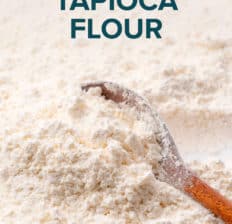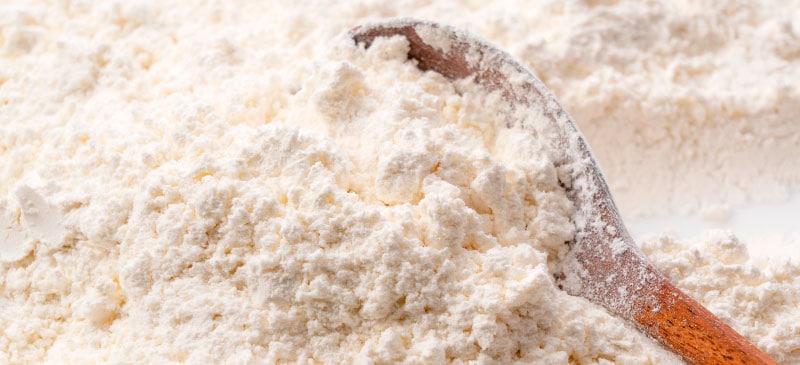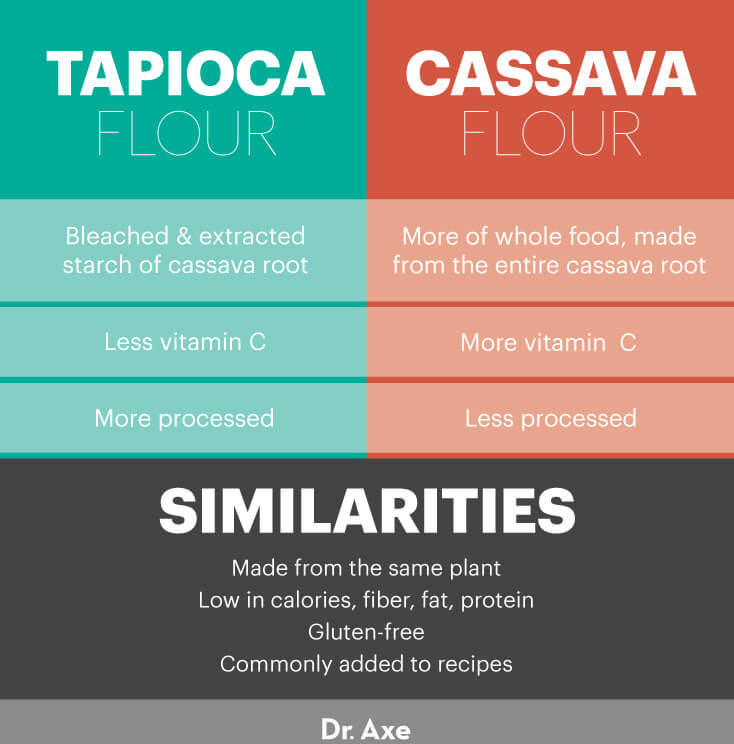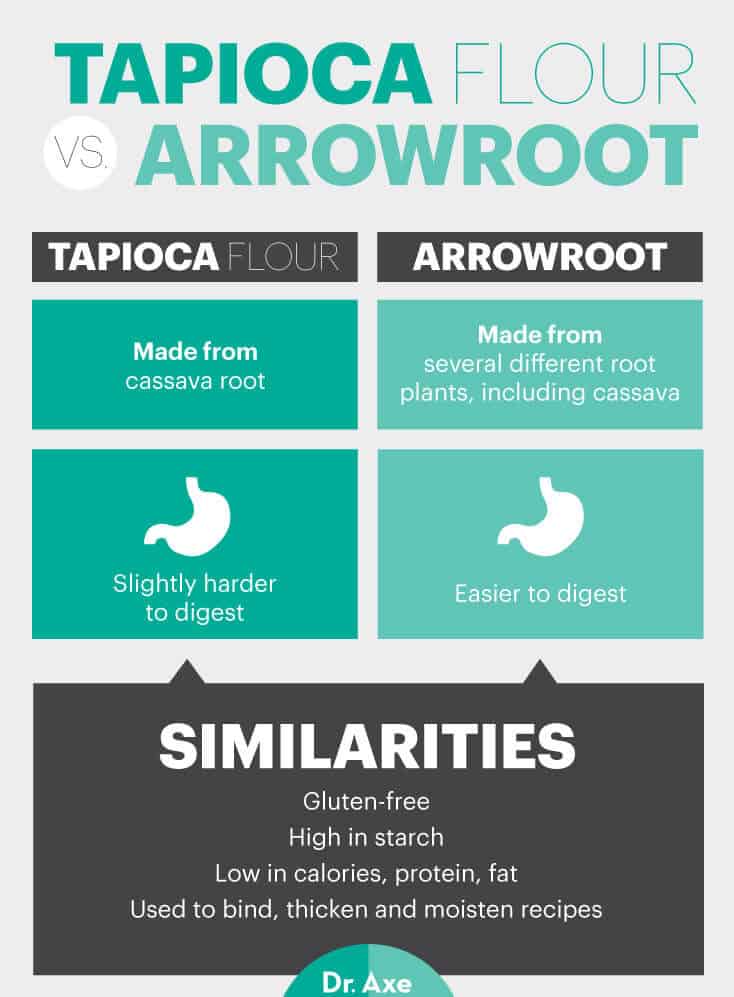


With the rise in popularity of gluten-free baking, tapioca flour has become a staple for many people. Because cassava roots, from which tapioca is derived, are naturally very high in carbohydrates, tapioca starch is able to be extracted and made into gluten-free flour or “pearls.” These are used as a thickening agent in various kinds of foods or recipes — everything from pizza dough to pie filling.
Tapioca tastes mild and slightly sweet and is one of the purest forms of starch there is. Besides carbs/starch, it’s very low in other macronutrients and micronutrients.
However, it’s totally gluten-free, low in calories and free from sugar — so it’s still overall useful in healthy, gluten-free cooking or baking, much like cassava flour.
What Is Tapioca Flour?
Tapioca is a type of starch extract that’s derived from the starchy vegetable called cassava root (Manihot esculenta). Today, cassava is mostly grown in parts of Africa, Asia and South America, and the entire cassava plant is considered an important staple crop that supplies millions of people with a significant portion of their daily calories.
While tapioca flour, pearls or other products won’t provide you with many essential nutrients, using tapioca makes it possible to re-create recipes like mousses, puddings, yogurts, jello, sauces, crock pot recipes and more without the use of regular all-purpose flour or other highly processed ingredients.
Ad


In some parts of the world, tapioca flour is even used to make flatbread, crusts, cakes, cookies, chips, tortillas and a milky-white liquid that’s similar to coconut or dairy milk.
If you have an allergy to nuts, coconut, other gluten-free grains and follow a low-FODMAP diet or gluten-free diet, then you’ll discover that tapioca really comes in handy.
Nutrition Facts
What does the nutritional makeup of tapioca flour look like? A quarter-cup serving of tapioca flour has about:
- 100 calories
- 26 grams carbohydrates
- close to zero sugar, fat and protein
Tapioca is made up of almost all carbohydrates and is very low in all types of fats, sugar, fiber, protein, sodium, and essential vitamins or minerals.
Tapioca Flour vs. Cassava Flour
Cassava flour and tapioca flour are similar and both made from the same plant — however, they’re different because cassava flour is more of a “whole food.”
Cassava roots are brown with rough skin, while the inside is softer and a yellow-white color. Tapioca is the bleached and extracted starch of the cassava root, while cassava flour is made from the entire root.
Cassava flour is still low in fiber, calories, fat and protein but has more vitamin C than tapioca flour.
Both products are suitable if you’re giving up gluten and are unlikely to trigger allergies. They’re both commonly added to recipes for thickening and have similar qualities.
However, overall some people prefer using cassava flour over tapioca flour (or starch) because it tends to be less processed. Extraction and processing are usually not needed to make cassava flour since the root is naturally grown, peeled, dried (traditionally outdoors in the sun) and then milled.
Tapioca can sometimes undergo more manufacturing, including high-heat pressing and chemical extracting, although the exact way that tapioca is made from cassava differs around the world. The less processed that tapioca flour is the better.
The starch should ideally be extracted from the cassava root by a repeated process of washing and pulping the mixture, which separates off the liquid from the root without requiring additives or other steps.
It’s possible that cassava flour is easier to digest for those with sensitive digestive systems because it’s less concentrated in pure starch. For most people, overall there isn’t a huge difference between the two, and the uses are similar, so it might be up to your preference.
Tapioca Flour vs. Arrowroot
Arrowroot is another starchy food product that’s a popular addition to gluten-free baking and similar to tapioca and cassava flour in many ways. Arrowroot is made from several different root plants, including cassava, but also other tropical plant varieties grown in Asia and Africa.
It’s high in starch, low-calorie, low in protein and fat, and free from all common allergens (gluten, nuts, seeds, dairy) — plus it’s vegan. Most people use it to bind, thicken and moisten recipes just like tapioca.
Arrowroot soaks up a good deal of water and forms a smooth, gel-like consistency similar to cornstarch or tapioca pearls. It’s commonly added to desserts, like puddings, cakes or custards, and also used in savory recipes, like hot sauces, milks and broth.
Ad


It’s suitable for those following the Paleo diet or gluten-free diet and is considered easy to digest, even for people with dietary restrictions, digestive problems or those who struggle with recurring diarrhea.
Health Benefits
Some of the benefits of using tapioca flour or other forms when cooking or baking include:
1. It’s Gluten-Free, Grain-Free and Nut-Free
There’s a reason people following the Paleo diet, FODMAP diet or autoimmune protocol diet love using tapioca: It’s totally grain-free, nut-free, dairy-free, vegan, seed-free, gluten-free and practically sugar-free.
Products made from cassava are easy to digest and often recommended for people with digestive issues like celiac disease, gluten intolerance, nut or seed allergies, diverticulitis, IBS, or IBD.
READ RELATED: 11 Science-Backed Benefits of Eating Strawberries
Tapioca flour is an alternative to traditional wheat flours, all-purpose flour or even nut-based flours, like almond meal. It has a variety of uses in healthy baking, without adding unwanted gluten or other ingredients.
Tapioca can usually be consumed by people with sensitive digestive systems or those who have a hard time eating other flours.
It’s even safe for those following a moderate form of the autoimmune protocol diet, which limits many sources of carbohydrates (like some fruits and most grains and dairy).
2. Low in Calories, Sugar and Fat
Tapioca has more carbohydrates and water proportionally than many other gluten-free flours, including buckwheat, teff, rice, corn, garbanzo, almond and coconut flour. Because it has very little protein, sugar or fat, it’s low in calories and can be used in many healthy recipes if you’re watching your weight.
Using tapioca in recipes can be a great way to reduce the use of butter, oil, cream or dairy. It’s suitable for people on a low-calorie diet and those with diabetes, high blood pressure symptoms, high cholesterol, allergies and digestive issues.


3. Tasteless and Odorless
Tapioca is virtually undetectable in recipes, which is why it’s used in both sweet and savory dishes. It has positive effects on the texture and “mouth-feel” of recipes — for example, by making baked goods more spongy and springy, promoting browning, and helping crusts to crisp up — but other than that it won’t disturb the taste of other ingredients much.
If you find the taste of other gluten-free or sprouted grain flours off-putting, then you’ll likely find tapioca to be a pleasant change.
4. Binds and Thickens Recipes
Compared to many other flours, tapioca absorbs and retains a higher water content, which means it does a great job of binding, thickening and moistening recipes. While gluten-free baking can sometimes be hard without the sticky and bouncy quality of gluten protein (found in wheat, rye and barley flours), adding some tapioca flour can help keep recipes from crumbling and getting too dry.
It won’t rise like yeast, which means it’s not always a success when using it to make breads or cakes, but it tends to help hold recipes together better than almond, garbanzo or coconut flour.


Products
In grocery stores you’ll find tapioca sold in several forms:
- Tapioca flour — has the consistency of a fine meal and is a common ingredient for gluten-free baking.
- Tapioca starch (usually just another name for tapioca flour) — a soluble powder, often used for thickening sauces and absorbing liquid. If a recipe calls for tapioca starch, you can easily use tapioca flour instead since the two are almost always the same thing.
- Tapioca pearls — small white/opaque pearls that dissolve when heated in water. The pearls are also called boba in some cultures and produced by passing moist tapioca starch through a sieve under high pressure.
- Tapioca flakes — come in either coarse or fine varieties and used the same way as starch/flour.
All types of tapioca are able to be used pretty interchangeably, however tapioca flour or starch tends to be the best variety to use when baking. Cassava root is made into tapioca flour (or tapioca starch) by peeling, grating and drying the starchy root; removing all the water and fiber; and forming a powdery, fine, granulated flour mixture.
Of all the types of tapioca sold today, tapioca pearls are the most widely available and commonly sold. If you’ve ever made or eaten “tapioca pudding,” chances are you’ve consumed tapioca pearls.
When used in cooking, tapioca absorbs a high amount of water and takes on a gel-like consistency. This is useful for mimicking the effects of fats, dairy products, cornstarch or some other common food additives.
How to Use
For the best results when cooking or baking with tapioca flour, use it in combination with other gluten-free flours. Tapioca flour, flakes, sticks and pearls form a smooth, gel-like substance after they soak up water, so they must be combined with enough liquid in order to become rehydrated.
Tapioca absorbs liquid almost immediately, especially if the liquid is heated and slowly stirred into the flour. Just a few drops of liquid can be enough to transform tapioca flour into a smooth, dough-like paste that might eventually be used to make things like bread or cake.
Tapioca is capable of absorbing water up to twice its volume, at which point is becomes “swollen,” very soft and thick, making it perfect for lending moisture to baked recipes or for thickening sauces. One of the great things about tapioca is that it’s virtually tasteless and odorless — plus it doesn’t have a color that changes the appearance of recipes. (It’s usually white when raw and almost see-through/translucent-looking once cooked.)
It’s also possible to now find tapioca pearls or sticks that have purposefully been colored, which are used to make things like jello or “bubble tea.”
Some popular ways for using tapioca flour in recipes include:
- adding crispness to pizza or pie crusts
- adding chewiness to baked goods, like cookies
- lending moisture to dense, gluten-free breads
- making pancakes or flatbread (such as they traditionally do in Brazil)
- forming filling for gluten-free berry tarts
- thickening sauces, soups or stews, such as those made in a crock pot (instant tapioca and tapioca starch are the best choices for thickening)
- helping form pie filling (usually instant tapioca or starch works better than pearls here)
- making pudding or custard
- replacing cornstarch (use two tablespoons tapioca flour for each one tablespoon cornstarch)
How Much Tapioca to Use:
- Usually tapioca flour can be subbed in a 1:1 ratio for wheat flour. For example, to substitute tapioca flour (or starch) for wheat/all-purpose flour in recipes, start by using about 1 tablespoon–1.5 tablespoons of tapioca for every tablespoon wheat flour in the original recipe.
- Depending on the producer, tapioca can be either coarsely ground or finer and pure starch. This means it’s not always going to react the same way in recipes, so try to read the package for clues and recommendations.
- Obviously, you need more tapioca for baking something like cookies than you do for thickening a sauce. A little tapioca flour usually goes a long way to thicken liquids.
- In gluten-free baking, you’ll likely get the best results if you don’t use tapioca flour exclusively, but rather in combination with other flours. When overused in a recipe, tapioca flour can make food slimy, so sometimes less is more. Although it won’t add much taste, odor or color to recipes, some people find its slippery texture off-putting (especially in sauces or stews), so do some experimenting to see how much you prefer.
Here are some tapioca flour recipes to try:
Risks and Side Effects
Because tapioca isn’t very high in bioavailable nutrients, it’s probably best not to overdo it and also to try pairing it with other nutrient-dense, complimentary foods. For example, rather than making sugary bubble tee with tapioca, you can use it to thicken homemade desserts like pudding or yogurt made with raw milk, avocado or coconut cream.
In order to increase the fiber content of recipes made with tapioca flour, try combining it with coconut or almond flour. For a boost in antioxidants, vitamins, minerals and healthy fats, considering adding superfoods like chia seeds, flaxseeds, sesame seeds, berries or raw honey to your recipes.
The Center for Food Safety in Hong Kong also warns that if processed incorrectly, the cassava plant can possibly become toxic. This is very rarely the case with commercially packaged tapioca, but toxicity has been reported several times in the past.
Tapioca naturally produces cyanide, which is poisonous to humans when it interacts with gut microbes in certain ways. Most cyanide is removed during peeling, cooking and processing, but rarely it does make its way into the food supply.
Cyanide is actually found in over 2,000 different plants, and when it causes cyanide poisoning, symptoms can include headaches, dizziness, a rapid pulse, weakness and fainting.
Although poisoning is very unlikely to occur when buying tapioca flour, it’s good to be aware of the risk when making your own flour.
Final Thoughts
- Tapioca is made up of almost all carbohydrates and is very low in all types of fats, sugar, fiber, protein, sodium, and essential vitamins or minerals.
- While it won’t provide you with many essential nutrients, using tapioca makes it possible to re-create recipes like mousses, puddings, yogurts, jello, sauces, crock-pot recipes and more without the use of regular all-purpose flour or other highly processed ingredients.
- Some of the benefits of tapioca include that it’s gluten-free, grain-free and nut-free; low in calories, sugar and fat; tasteless and odorless; and binds and thickens recipes.
- It comes in many forms, such as flour, starch, pearls and flakes. All types of tapioca are able to be used pretty interchangeably, however tapioca flour or starch tends to be the best variety to use when baking.
!function(f,b,e,v,n,t,s)
{if(f.fbq)return;n=f.fbq=function(){n.callMethod?
n.callMethod.apply(n,arguments):n.queue.push(arguments)};
if(!f._fbq)f._fbq=n;n.push=n;n.loaded=!0;n.version=’2.0′;
n.queue=[];t=b.createElement(e);t.async=!0;
t.src=v;s=b.getElementsByTagName(e)[0];
s.parentNode.insertBefore(t,s)}(window, document,’script’,
‘
fbq(‘init’, ‘3475171552810057’);
fbq(‘track’, ‘PageView’);





